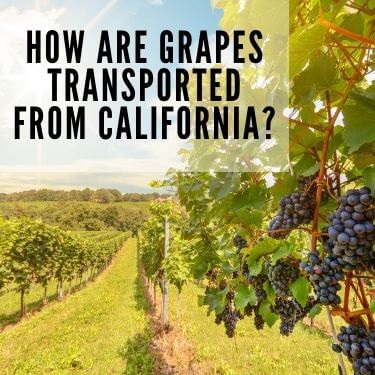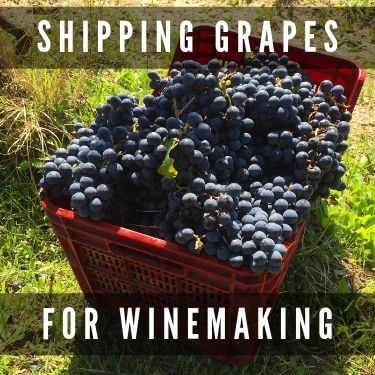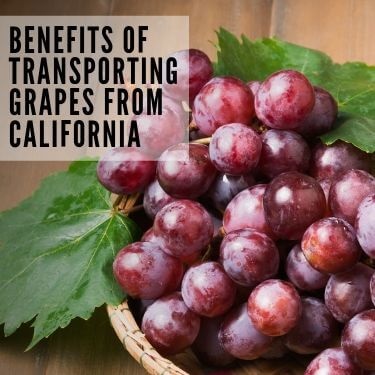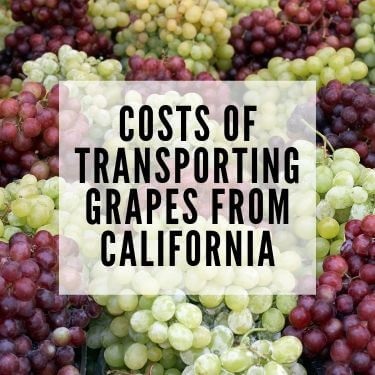California is the biggest producer of grapes in the U.S. In fact, 99 percent of the commercially grown table grapes in the U.S. come from vines in California. So, if you find yourself wondering “how are grapes transported?” then you’ll need to look towards the vineyards in California for your answer. If you have grapes to ship, learning more about the process before you start can save you trouble later down the road.
How are grapes transported? The answer is simple: very carefully. Grapes are very sensitive to impact because they have thin skins. They are also sensitive to changes in temperature. Grapes are often transported:
The art of transporting grapes in California has a long legacy. According to information from the California Table Grape Commission, William Wolfskill was the first California grape farmer to ship grapes. He planted the state’s first vineyard in what is now Los Angeles in 1839 and was soon shipping fresh grapes to Northern California via horse and buggy. From there, the California grape industry boomed, along with the transport of fruit and vegetables. An agricultural entrepreneur named R.B. Blowers shipped grapes from California to Chicago by train in 1869.
California is now home to 880,000 square acres of grape vineyards, with roughly 25,000 farmers growing grapes of all kinds across the state. Not only that, California has the most wineries and makes the most wine out of all 50 states. With such a huge fraction of the market share, it’s no surprise that California generated $5.79 billion in grape sales in 2017.

In order to transport grapes, they need to be ripe and healthy. Grapes won’t continue to ripen after they are harvested, so they need to be picked at just the right time. Before transport, grapes need to:
In addition to that, if a bunch of grapes is not visually appealing, even if there is nothing really wrong with it, chances are it won’t be happily received by the customer. Ensure that all grapes are the correct color, size, and ripeness before attempting to transport them, otherwise they may get rejected for not meeting quality standards.
Nowadays, grapes must be packaged in a very particular way to achieve the best results. Grapes often have a long transit when moving out of California, which means they can’t exactly be thrown in a buggy and pulled by horses anymore.
Most of the time, California grapes are predominantly shipped in plastic bags with little holes for ventilation, and a ziplock style slider seal. Sometimes, standard clamshell packaging is utilized instead, to offer a little more protection to the delicate fruits. Then, those smaller containers are packaged in a sturdy 10kg (22lb) crate or carton with wool, polyethylene, or cardboard to protect it. These cartons then must be palletized for easy shipping.
To palletize grape shipments, here are a few best practices to ensure success:
Palletizing your shipment has many benefits. Not only does it protect the freight better, it also makes it much easier to handle for the carrier transporting it. The pallet allows for the use of forklifts, and the uniform shape makes it easy to pack in the back of a truck. In some cases, your freight may incur extra fees if it is not palletized, or if it was palletized incorrectly. Although palletizing freight can take time, the benefits far outweigh the inconvenience.
Grapes intended for wine or juice must be packaged differently from consumer table grapes. Because juice and wine grapes are not sold to supermarkets for consumers, they do not need to be individually packaged for the grocery store shelves. Instead, wine and juice grapes must be packaged and marketed in bulk containers to be sent to juice makers and winemakers.
To transport grapes for wholesale, growers typically utilize wooden or plastic pallet bins. The bins are the same width and length as a normal pallet, so that makes it easy to transport with a forklift. There is no standard height for a pallet bin, and it may be able to accommodate as little as 12 to as many as 50 bushels depending on the type. Once packed, these pallet bins can be treated just like normal pallets, and can be stacked on top of each other as long as the bin itself is sturdy.

Although pallet bins are a popular choice because of the low cost, there are many other options for shipping bulk grapes to a juice maker or winemaker, like:
California grapes often move by the truckload. Transporting grapes and other fresh fruit with a short shelf life involves something called the Cold Chain Logistics Process. This process involves moving and storing fruits, vegetables, and other commodities at a certain cool temperature. This is especially important for grapes, as they are quite delicate and extremely sensitive to changes in temperature.
“Cold Chain” means that every step in the logistics process must keep the fruit at a specific temperature throughout its entire transit, from start to finish. Since there are often many stops in the logistics process, that means more than just the truck that moves the grapes needs to be kept cold. Warehouses, trucks, and destination ports must all be the correct temperature to keep the grapes fresh. This is true for any space that holds the shipment, even if only for a short time.
A temperature of 0 degrees Celsius, or 32 degrees Fahrenheit, is recommended for storing and transporting grapes. If at any point in the process, the shipment is stored at the wrong temperature, it is likely to be rejected at the destination. This can result in profit loss for the carrier, the shipper, and any involved third parties. To ensure that this does not happen, it is important to only work with trusted, highly qualified carriers.
As with any perishable food, grapes must be transported quickly to ensure freshness. If a shipment takes too long, it may spoil before it reaches its destination—even if it was kept at the correct temperature the whole time!
Even though grapes won’t continue to ripen after harvest, the fruit’s metabolic processes will continue. The grapes can absorb oxygen and excrete carbon dioxide after harvest. This causes starch in the grapes to turn into sugar and can make them go bad. It is important to be aware of this natural process during shipping.
Even if the grapes are not spoiled by the time they reach their destination, their shelf life could be severely compromised, depending on the delays the shipment experienced in transit. For perishable deliveries, even a delay of a single day could have serious consequences.
For this reason, it is important to make sure you have many warehouse locations around the U.S. if you intend to ship your grapes around the nation. This way, the transit time between the warehouse and the destination can be significantly reduced, and the grapes can arrive as fresh as possible.
If you’ve ever looked at grapes in the supermarket that were past their prime, you might have noticed a grey, moldy-looking film on some of the old grapes. This is an unfortunate side effect of improper storage during transit or in storage.
It is very important to be aware of fungus and bacteria when transporting grapes. In fact, fungus is one of the most common and obvious causes of grape deterioration when in storage and being transported. A fungus called Botrytis cinerea is a common cause of wine grape and table grape deterioration. Sometimes called Botrytis bunch rot, this fungus causes grapes to rot and covers them with a grey coating.
Packaging is important when it comes to preventing fungus. Bacteria and fungi require a moist environment to grow, so precautions should be made to ensure that the packaging is not too moist, but not so dry that the grapes shrivel up. Crates and cartons should be well ventilated to encourage airflow, so moisture does not accumulate or stagnate. Grapes should be kept in a semi-humid environment for best results, but there is a fine line between humidity and moisture.
To make sure the shipment is kept at the proper humidity levels, you should inform your carrier of the specific requirements that apply to your shipment. If you fail to properly inform your carrier, they won’t be held liable if the grapes spoil in transit. Alternatively, you could enlist the help of a freight broker, who would communicate with the carrier on your behalf. They would also be responsible for researching the requirements of your shipment and keeping the carrier well informed of the expectations. They keep track of all the rules that apply to freight shipping grapes, and can be a huge asset to a busy shipper.
Another tactic used to try to control bacteria, fungi, and diseases is fumigation. Grapes that are selected for shipment are treated with a gas called Sulfur Dioxide to kill the Botrytis Cinerea that may have already infected the plant and protect against future contamination of the disease. Although the thought of fumigating produce for consumption sounds scary, it is not detrimental to the quality of the grapes or the health of the consumer.
There are two main ways that grapes get fumigated with sulfur dioxide: Total Utilization and sulfur dioxide releasing pads.
Fumigating grapes is a tricky process since they are a notoriously delicate fruit. The levels of sulfur dioxide used to fumigate grapes have to be carefully calculated since overexposure could ruin the quality of the grapes.
Signs that the grapes were overexposed to sulfur dioxide are:
Despite concerns about the use of sulfur dioxide to fumigate grapes, it is perfectly safe to use as treatment. Unless a consumer is allergic to sulfites, it will not be harmful to consume. It must also be labeled on the front of the packaging, so consumers always know when the grapes they are buying have been treated. Additionally, because of the low levels of residue it leaves behind, only trace amounts actually get consumed anyway.
As an added benefit to sulfur dioxide fumigation, the process actually prevents the stems of the grapes (called the rachis) from turning brown, which makes the whole bunch look much more visually pleasing and marketable.
Most of the grapes that come out of California hail from the regions of Coachella and San Joaquin, where the conditions are optimal for growing the highest quality grapes. Those two regions are responsible for more than 85 different varieties of grapes, and the unique climate produces the plumpest, sweetest grapes.
Besides the unparalleled taste, California grapes offer a range of health benefits. Grapes contain more than 1,600 phytonutrients, which are nutrients that help protect the plant from various environmental threats. However, new research shows that those phytonutrients found in grapes have been linked to:

They are also a great source of antioxidants and polyphenols, which contributes to their healthy properties.
Finally, California is a unique environment for shipping freight of all kinds, because of the huge system of highways, railways, and ports of entry that make the state a center of shipping. Millions of tons of freight are transported through California on a daily basis, making it the largest freight center in the U.S.
Shipping costs are a major consideration for any producer or manufacturer, and it is one of the most important aspects of a business. Shipping your products around the U.S. and the world brings it to the consumers, so they can more readily make a purchase, and drive immense revenue. If you only sold locally, you would severely limit your potential revenue, so it is incredibly important for any growing business to expand into the realm of interstate shipping.
Grapes must be shipped in a full truckload, or FTL, shipment. Because they must be kept cold during the shipping process, the container should not be opened until it reaches the destination, so it can keep its temperature. This makes shipping grapes a little more expensive than shipping something like plastic trinkets, which can be shipped LTL.

Some of the factors that are used to determine the cost of the shipment are:
Unfortunately, because of those different factors influencing the price, the final cost of the shipment is impossible to state generally. Each shipment is going to be different. If you want to know the cost of your specific shipment, the best way to do that is to get a quote from a shipping company or a third-party logistics company, like R+L Global Logistics.
Now that you can answer the question “how are grapes transported?” it’s time to get your next shipment out of the vineyard and onto a truck. We also handle almonds and other freight shipping in California. When you need to run a shipment of delicate freight like grapes and other freight shipping from California to Arizona and more, you need an experienced truckload freight broker who can match you with a carrier to get your grapes there on time and intact. R+L Global Logistics can make transporting grapes into and out of California easy.
Call to request a quote today!

R+L Global Logistics
315 NE 14th St., Ocala, FL 34470